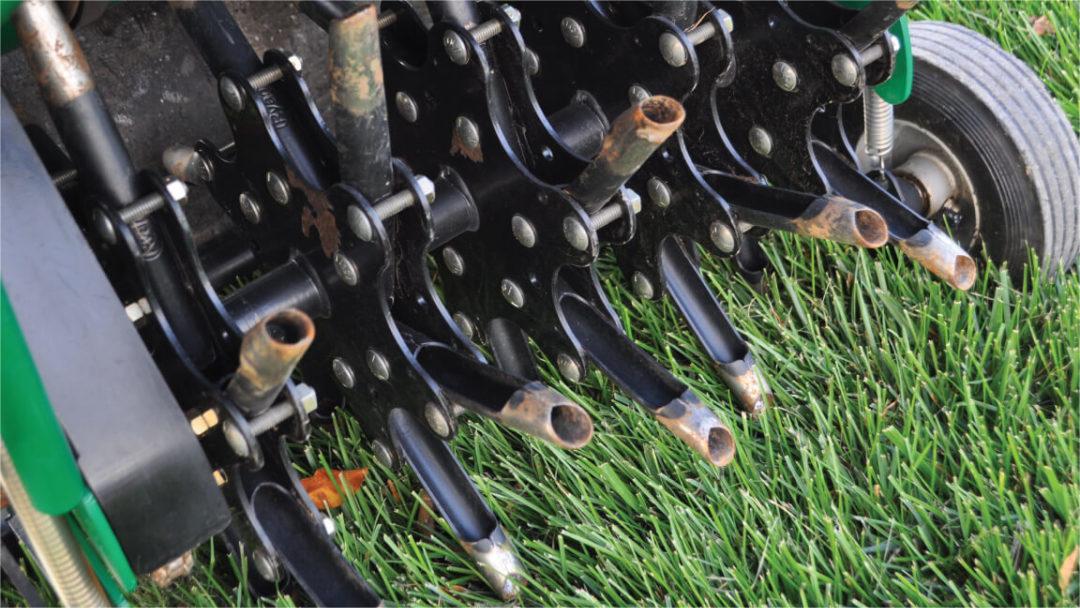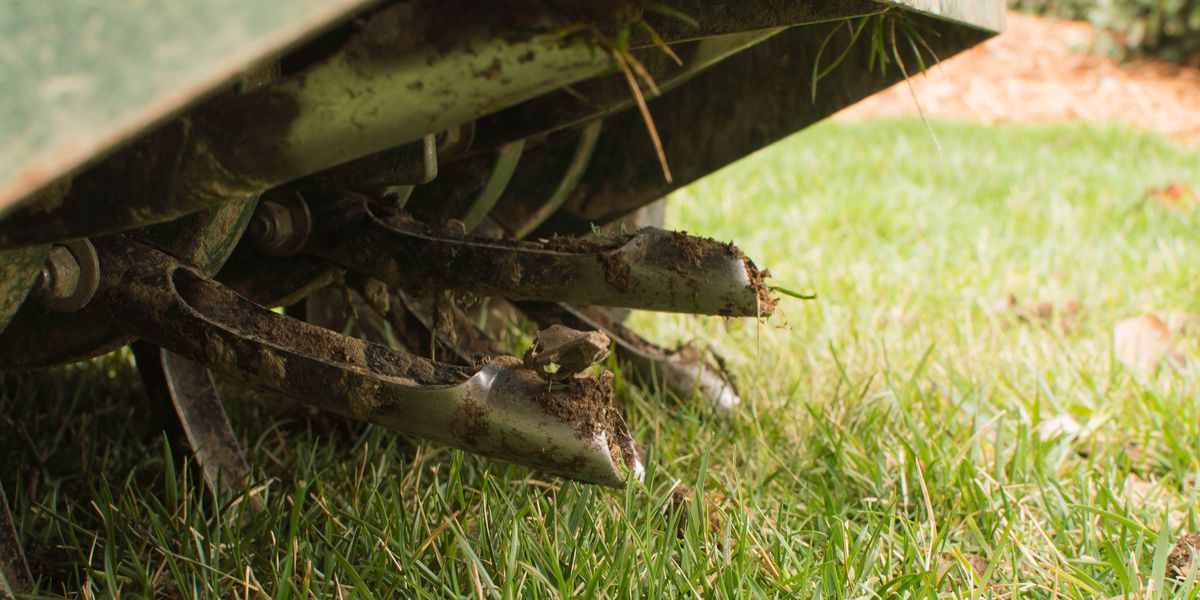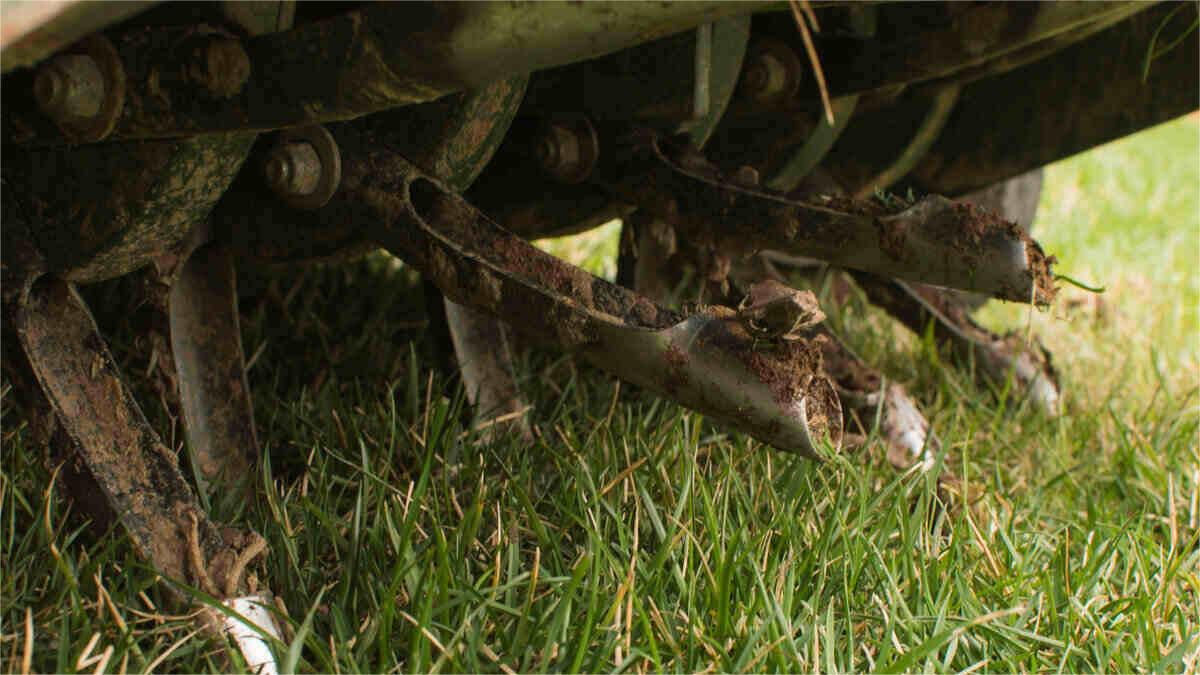Lawn aeration is a crucial aspect of lawn care maintenance. It involves perforating the soil with small holes to allow air, water, and nutrients to penetrate the grass roots. Aeration helps in alleviating soil compaction and promoting healthy grass growth. Two primary methods of lawn aeration are core aerators and spike aerators.

Understanding Core Aerators
Core aerators are the unsung heroes of lawn care, silently working beneath the surface to breathe new life into your turf. In this comprehensive guide, we'll delve into the depths of core aerators, uncovering their benefits, techniques, and everything in between.
Why Core Aeration Matters
Core aeration is not just another lawn care fad; it's a vital practice for maintaining healthy, lush grass. By perforating the soil with evenly spaced holes, core aerators facilitate better air circulation, water penetration, and nutrient absorption. This process revitalizes compacted soil, allowing grassroots to thrive and flourish.
The Benefits of Core Aeration
Enhanced Soil Structure: Core aeration alleviates soil compaction, promoting healthier root growth and reducing runoff.
Improved Nutrient Uptake: By loosening the soil, core aerators enable roots to access essential nutrients more efficiently, leading to greener, more resilient grass.
Enhanced Water Absorption: Compacted soil repels water, leading to puddling and drainage issues. Core aeration promotes better water infiltration, minimizing water wastage and preventing soil erosion.
Thatch Reduction: Over time, organic debris accumulates on the soil's surface, forming a dense layer known as thatch. Core aerators help break down thatch, preventing it from suffocating the grass and impeding root growth.
When to Aerate Your Lawn
Timing is crucial when it comes to core aeration. While it's tempting to aerate whenever the mood strikes, there are optimal seasons for this task. For cool-season grasses like Kentucky bluegrass and fescue, early fall is ideal, as it allows ample time for recovery before winter dormancy. Conversely, warm-season grasses such as Bermuda and Zoysia benefit from aeration during late spring or early summer when they're actively growing.
How to Aerate Like a Pro
Aerating your lawn may seem daunting, but with the right tools and techniques, it's a breeze. Here's a step-by-step guide to achieving professional results:
Prepare the Lawn: Before aerating, mow your lawn to a moderate height and water it thoroughly. This softens the soil and makes it easier for the aerator to penetrate.
Choose the Right Equipment: Select a core aerator that suits your lawn size and terrain. For small to medium lawns, a manual or walk-behind aerator is sufficient, while larger lawns may require a tow-behind or ride-on aerator.
Aerate in a Crisscross Pattern: To ensure thorough coverage, aerate your lawn in two directions, overlapping each pass by a few inches. This ensures that no area is missed and promotes uniform soil loosening.
Leave the Cores: Don't be tempted to remove the soil cores left behind by the aerator. These cores contain valuable nutrients and organic matter that will break down naturally, enriching the soil in the process.
Follow Up with Overseeding and Fertilization: After aerating, consider overseeding to fill in any bare patches and applying a high-quality fertilizer to nourish the revitalized turf.
Core aerators may not steal the spotlight, but their impact on lawn health is undeniable. By incorporating core aeration into your lawn care regimen, you can unlock the full potential of your turf, ensuring a lush, vibrant lawn that's the envy of the neighborhood. So, don't wait—let your lawn breathe easy with core aeration today!

Understanding Spike Aerators
Spike aerators, often overshadowed by their core aerator counterparts, play a pivotal role in nurturing healthy lawns. In this illuminating discourse, we delve into the intricacies of spike aerators, unraveling their significance and techniques for optimal usage.
Deciphering Spike Aerators
Spike aerators, distinguished by their spiked tines, operate by puncturing the soil surface to enhance aeration and promote grassroots growth. Unlike core aerators, which extract plugs of soil, spike aerators create holes without removing any soil. While they may not offer the same soil compaction relief as core aerators, spike aerators excel in facilitating air and water penetration, thereby fostering a conducive environment for robust root development.
The Advantages of Spike Aerators
Enhanced Soil Aeration: By perforating the soil with spikes, these aerators improve air circulation, ensuring that roots receive an ample oxygen supply for optimal growth.
Promotion of Water Absorption: Spike aerators facilitate better water infiltration, preventing surface runoff and ensuring that moisture reaches the root zone, essential for maintaining healthy turf.
Cost-Effectiveness: Compared to core aerators, spike aerators are often more affordable and accessible, making them a practical choice for homeowners seeking to improve lawn health on a budget.
When to Utilize Spike Aerators
Choosing the right time to aerate with spike aerators is crucial for maximizing effectiveness. Ideally, aerate when the soil is slightly moist but not overly wet to prevent excessive soil compaction. Spring and fall are optimal seasons for spike aeration, coinciding with periods of active growth and minimal stress on the grass.
Mastering Spike Aeration Techniques
Achieving optimal results with spike aerators requires proper technique and attention to detail. Follow these steps to ensure success:
Prepare the Lawn: Prior to aeration, mow the lawn to an appropriate height and water it thoroughly. This softens the soil and facilitates easier penetration of the spike aerator tines.
Aerate in a Grid Pattern: To ensure even coverage, aerate the lawn in a grid pattern, overlapping each pass to prevent missed areas. This promotes uniform soil aeration and encourages consistent root development.
Adjust Depth Settings: Most spike aerators feature adjustable depth settings, allowing you to customize the depth of aeration based on soil conditions and turfgrass species. Aim for a depth of 1 to 2 inches for optimal results.
Consider Multiple Passes: For heavily compacted soil or areas with poor drainage, consider making multiple passes with the spike aerator to enhance soil aeration and alleviate compaction.
Follow Up with Lawn Care Practices: After aeration, follow up with overseeding to fill in any bare patches and apply a balanced fertilizer to provide essential nutrients for healthy turf growth.
While core aerators may steal the limelight, spike aerators deserve recognition for their role in promoting lawn health. By understanding the principles and techniques of spike aeration, homeowners can harness its benefits to cultivate lush, resilient lawns that stand the test of time. So, embrace the power of spike aerators and embark on a journey towards a greener, more vibrant lawn today!

Comparison between Core Aerators and Spike Aerators
When it comes to lawn aeration, two primary methods reign supreme: core aerators and spike aerators. Each technique boasts its own set of advantages and considerations, making it essential for homeowners to understand the nuances of both. In this comprehensive comparison, we dissect the effectiveness, soil compaction relief, cost, ease of use, and long-term impact of core aerators versus spike aerators.
1. Aeration Effectiveness
Core Aerators:
Extract plugs of soil, creating channels for air, water, and nutrients to penetrate deep into the root zone.
Promote better soil structure and encourage robust root growth, leading to healthier, more resilient turf.
Spike Aerators:
Puncture the soil surface with spiked tines, facilitating air and water infiltration without removing soil cores.
Provide moderate aeration benefits, primarily improving surface drainage and promoting shallow root development.
Verdict: Core aerators typically offer superior aeration effectiveness, penetrating deeper into the soil and promoting healthier root growth compared to spike aerators.
2. Soil Compaction Relief
Core Aerators:
Effective at alleviating soil compaction by removing plugs of soil, allowing the soil to loosen and roots to penetrate deeper.
Ideal for addressing moderate to severe compaction issues and rejuvenating compacted lawns.
Spike Aerators:
Provide minimal relief for soil compaction, as they merely puncture the soil surface without removing soil cores.
More suitable for maintaining lightly compacted soils or as a supplemental aeration method for ongoing lawn care maintenance.
Verdict: Core aerators excel in relieving soil compaction, making them the preferred choice for addressing compacted soil conditions.
3. Cost Comparison
Core Aerators:
Generally more expensive to purchase or rent compared to spike aerators due to their mechanical complexity and the need for additional machinery.
However, may offer better long-term value in terms of aeration effectiveness and long-lasting results.
Spike Aerators:
Typically more affordable to purchase or rent, making them an attractive option for budget-conscious homeowners.
Provide a cost-effective solution for routine lawn maintenance and surface-level aeration needs.
Verdict: Spike aerators are more budget-friendly upfront, while core aerators may offer better value in terms of long-term effectiveness and results.
4. Ease of Use
Core Aerators:
Require more effort to operate due to their heavier weight and mechanical components.
May necessitate additional machinery, such as a tractor or riding mower, for larger lawn areas.
Spike Aerators:
Lightweight and easy to maneuver, making them suitable for homeowners of all skill levels.
Can be operated manually or attached to a walk-behind mower for added convenience.
Verdict: Spike aerators are generally easier to use and require less effort compared to core aerators, making them more accessible for DIY lawn care enthusiasts.
5. Results and Long-Term Impact
Core Aerators:
Provide deeper soil penetration and more significant long-term benefits for soil health and turf vitality.
Ideal for revitalizing compacted soils and promoting sustainable lawn growth over time.
Spike Aerators:
Offer moderate short-term benefits, primarily improving surface aeration and water infiltration.
Best suited for routine maintenance and surface-level aeration, with less pronounced long-term impacts compared to core aerators.
Verdict: While spike aerators offer immediate benefits, core aerators deliver superior long-term results, making them the preferred choice for homeowners seeking lasting improvements in soil health and lawn vitality.
In conclusion, both core aerators and spike aerators have their respective strengths and weaknesses. Homeowners should consider factors such as soil condition, lawn size, budget, and long-term goals when choosing between the two. Whether addressing soil compaction, promoting healthy root growth, or maintaining overall lawn health, selecting the right aeration method is key to achieving a lush, vibrant lawn that stands the test of time.
Which One Should You Choose?
When faced with the decision between core aerators and spike aerators, several factors come into play. To make an informed choice that aligns with your lawn care needs and preferences, consider the following factors:
1. Soil Condition:
Evaluate the current state of your soil, considering factors such as compaction level, drainage issues, and overall health.
If your soil is heavily compacted or in need of deep aeration, core aerators may offer more effective relief.
For lighter compaction or routine maintenance, spike aerators can provide sufficient aeration benefits.
2. Lawn Size and Terrain:
Assess the size and terrain of your lawn, as well as any obstacles or challenges present.
For larger lawns with open terrain, core aerators equipped with tow-behind attachments may offer efficiency and coverage.
In smaller or more confined spaces, spike aerators are lightweight and maneuverable, making them a practical choice.
3. Budget and Cost Considerations:
Determine your budget for aerator purchase or rental, considering both upfront costs and long-term value.
While core aerators may have a higher initial investment, they often deliver more significant long-term benefits and durability.
Spike aerators provide a more budget-friendly option, suitable for homeowners seeking cost-effective solutions for routine maintenance.
4. Time and Effort:
Assess your availability and willingness to dedicate time and effort to lawn care tasks.
Core aerators typically require more effort to operate, especially for larger lawn areas, and may necessitate additional equipment.
Spike aerators are easier to use and require less physical exertion, making them suitable for homeowners with limited time or mobility.
5. Long-Term Goals and Results:
Consider your long-term goals for lawn health, aesthetics, and sustainability.
Core aerators offer deeper soil penetration and more significant long-term benefits for soil health and turf vitality.
Spike aerators provide immediate results and are suitable for routine maintenance but may have less pronounced long-term impacts.
Personal Preferences:
Take into account your personal preferences, gardening style, and comfort level with different lawn care techniques.
Some homeowners may prefer the simplicity and ease of use offered by spike aerators, while others may value the deeper aeration benefits provided by core aerators.
Ultimately, choose the aerator that best aligns with your preferences, lifestyle, and overall lawn care philosophy.
Consider opting for core aerators if you:
Have a large lawn with significant soil compaction issues.
Prioritize long-term lawn health and vitality.
Are willing to invest in a higher-quality aeration solution.
On the other hand, choose spike aerators if you:
Have a smaller lawn or limited storage space.
Are on a tight budget.
Need a simple and easy-to-use aeration tool for occasional maintenance.
In the debate of core aerators vs. spike aerators, both have their merits depending on your specific lawn care needs. Core aerators offer superior aeration effectiveness and long-term benefits, while spike aerators provide a cost-effective and straightforward solution for lighter aeration tasks. Ultimately, the choice boils down to your lawn size, soil condition, and budget.
Post time: Feb-28-2024

